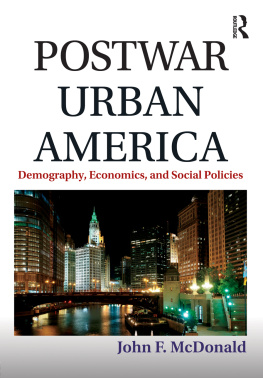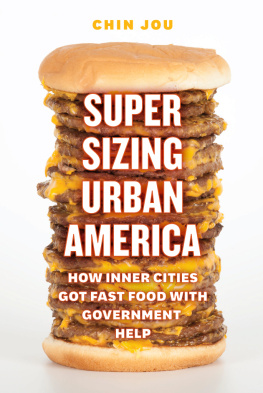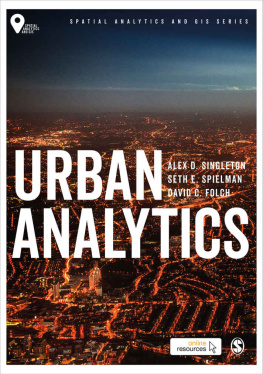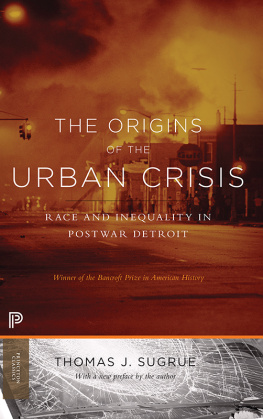
POSTWAR URBAN AMERICA
This book presents an analytical history of postwar urban America as a drama in four acts, with the goal of identifying the demographic, economic, and political factors that gave rise to positive outcomes. After a brief transition to peacetime, urban America experienced robust growth from 1950 until roughly 1970. The end of this first act was announced years in advance when riots erupted in the Watts section of Los Angeles in August 1965. There were many signs of trouble brewing in urban areas, and the blizzard of programs that was the Great Society was partly in response to those problems. The decline of the major cities and the attendant social problems were all related and reinforced one another during these years.
Act 2 was a bad time for cities and the people who lived in them, but it did end, and sometime after 1990, the downward spiral that had gripped Americas cities stopped and Act 3 began. To be sure, urban America still suffered from many problems, but many things were getting better, not worsefor example, the murder rate in the United States dropped to levels that had not been seen since before the start of the urban crisis in the mid-1960s. It was time to focus on what was working and how to keep the momentum of social and economic progress going. Unfortunately, however, Act 4 brought a reversal of the hopeful trends of the 1990s, as a relatively small recession in 2001 was followed by a weak recovery. Then came the financial crisis of 2008 and the deepest recession since the Great Depression, with across-the-board increases in poverty.
A primary task of this book is to study the major urban areas of the United States to understand why this all happened the way it did. The method followed is to identify seventeen urban areas in the North, fifteen in the South, and eight in the West and then study them from 1950 to 2010. Most of the chapters present detailed examinations of either the northern urban areas or the urban areas in the South and West during one of the acts in the dramathe time periods we call growth, crisis, rebirth, and new century. The hope is that this analysis will help stimulate the thinking that is needed to recognize that some urban areas have been more successful than others, that a rebirth did take place in urban America in the 1990s, and that the task going forward is to nurture and enhance the positive forces that can play a role once again.
John F. McDonald is Emeritus Professor of Economics and Finance at the University of Illinois at Chicago, USA, and Gerald W. Fogelson Distinguished Chair in Real Estate, Emeritus, at Roosevelt University, USA.
POSTWAR URBAN AMERICA
Demography, Economics, and Social Policies
John F. McDonald

First published 2015
by Routledge
711 Third Avenue, New York, NY 10017
and by Routledge
2 Park Square, Milton Park, Abingdon, Oxon, OX14 4RN
Routledge is an imprint of the Taylor & Francis Group, an informa business
2015 Taylor & Francis
The right of John F. McDonald to be identified as author of this work has been asserted by him in accordance with sections 77 and 78 of the Copyright, Designs and Patents Act 1988.
All rights reserved. No part of this book may be reprinted or reproduced or utilised in any form or by any electronic, mechanical, or other means, now known or hereafter invented, including photocopying and recording, or in any information storage or retrieval system, without permission in writing from the publishers.
Trademark notice: Product or corporate names may be trademarks or registered trademarks, and are used only for identification and explanation without intent to infringe.
Library of Congress Cataloging in Publication Data
McDonald, John F., 1943
Postwar urban America : demography, economics, and social policies / by John F. McDonald.
pages cm
Includes bibliographical references and index.
1. United StatesPopulationHistory20th century. 2. United StatesPopulationHistory21st century. 3. Cities and townsUnited StatesHistory20th century. 4. Cities and townsUnited StatesHistory21st century. 5. Metropolitan areasUnited StatesHistory20th century. 6. Metropolitan areasUnited StatesHistory21st century. 7. United StatesEconomic conditions1951Regional disparities. I. Title.
HB3505.M39 2014
307.760973dc23
2014020149
ISBN: 978-0-7656-4607-1 (hbk)
ISBN: 978-0-7656-4608-8 (pbk)
ISBN: 978-1-315-71871-2 (ebk)
Contents
. Much of the urban affairs literature consists of studies of individual urban areas or cities or of statistical studies of the 300-plus metropolitan areas. This book takes a different approach in that I include a more select group of major urban areas so that some of their individual features can be described and compared. Unique aspects of New York, Los Angeles, and Chicago are identified, as are features of places such as Birmingham, Indianapolis, and Phoenix, and nontechnical terms are used throughout.
Nearly all the major urban areas grew rapidly during 1950 to 1970. Indeed, these decades were the time in which the urbanization of the South began in earnest. The transformation of the South from a backward region in 1950 to a modern economy is a story of urbanization. The fifteen urban areas that grew to populations of more than 1.5 million are included in the chapters on the South. The next two decades were ones of urban crises, especially, but not exclusively, in the North. The 1990s are marked by a robust national economy and reversal of negative trends in many urban areas and central cities. However, the first decade of the twenty-first century was one of weak recovery from the recession of 2001, emergence of a housing market bubble, and financial crisis. The effects on cities were negative, but they were stronger in some metropolitan areas. Thus, one major purpose of this book is to draw lessons from this history. Why have some metropolitan areas and their central cities fared better than others in recent decades? Can those metropolitan areas that have struggled do better? How?
attempt to bring historical perspective to the urban crisis that gripped most major cities in the United States for roughly the two decades of the 1970s and 1980s. The historical perspective includes the legacy of slavery that was amply documented by Gunnar Myrdal in An American Dilemma (1944). The period of rapid urban growth and Great Migration from the South after World War II substantially improved the lives of most Americans, but also produced the tensions and frustrations that led to violent outbursts in the 1960s. The period of urban crisis followed, and that crisis was visited primarily on black Americans in the cities. The descent of the cities during this time provided the reasons for many to lose hope for the cities, and many still are in this frame of mind.
In many urban areas, the period of descent came to an end sometime around 1990. An important part of this book is the study of the urban rebirth that occurred. This study also shows that urban rebirth was far from complete and was fragile. Nevertheless, the 1990s provide some important lessons for urban areas.
, a detailed examination of the macroeconomy and the financial system as they developed over the decade, the specific events of the financial crisis, the resulting deep recession, and the policy responses to the crisis. It provides the background for chapters on what transpired in the urban areas of the North, South, and West. The special case of Detroit and its bankruptcy filing merits a separate chapter.
Next page









